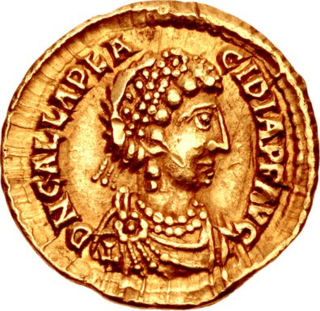
Galla Placidia, daughter of the Roman emperor Theodosius I, was a mother, tutor, and advisor to emperor Valentinian III. She was queen consort to Ataulf, king of the Visigoths from 414 until his death in 415, briefly empress consort to Constantius III in 421, and managed the government administration as a regent during the early reign of Valentinian III until her death.
The 420s decade ran from January 1, 420, to December 31, 429.
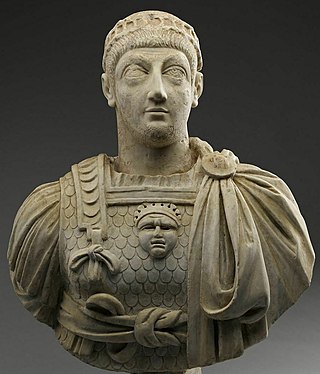
Valentinian III was Roman emperor in the West from 425 to 455. Starting in childhood, his reign over the Roman Empire was one of the longest, but was dominated by civil wars among powerful generals and the invasions of late antiquity's Migration Period.

Flavius Aetius was a Roman general and statesman of the closing period of the Western Roman Empire. He was a military commander and the most influential man in the Empire for two decades (433–454). He managed policy in regard to the attacks of barbarian federates settled throughout the West. Notably, he mustered a large Roman and allied (foederati) army in the Battle of the Catalaunian Plains, ending a devastating invasion of Gaul by Attila in 451, though the Hun and his subjugated allies still managed to invade Italy the following year, an incursion best remembered for the ruthless Sack of Aquileia and the intercession of Pope Leo I.

Constantius III was briefly Western Roman emperor in 421, having earned the throne through his capability as a general under Honorius. By 411 he had achieved the rank of magister militum, and in the same year he suppressed the revolt of the usurper Constantine III. Constantius went on to lead campaigns against various barbarian groups in Hispania and Gaul, recovering much of both for the Western Roman Empire. He married Honorius's sister Galla Placidia in 417, a sign of his ascendant status, and was proclaimed co-emperor by Honorius on 8 February 421. Constantius reigned for seven months before dying on 2 September 421.
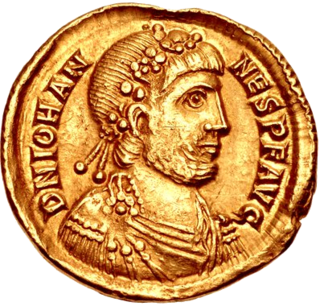
Joannes or John was Western Roman emperor from 423 to 425.

Gallia Belgica was a province of the Roman Empire located in the north-eastern part of Roman Gaul, in what is today primarily northern France, Belgium, and Luxembourg, along with parts of the Netherlands and Germany.

The Salian Franks, also called the Salians, were a northwestern subgroup of the early Franks who appear in the historical record in the fourth and fifth centuries. They lived west of the Lower Rhine in what was then the Roman Empire and today the Netherlands and Belgium.

Ripuarian or Rhineland Franks were one of the two main groupings of early Frankish people, and specifically it was the name eventually applied to the tribes who settled in the old Roman territory of the Ubii, with its capital at Cologne on the Rhine river in modern Germany. Their western neighbours were the Salii, or "Salian Franks", who were named already in late Roman records, and settled with imperial permission within the Roman Empire in what is today the southern part of the Netherlands, and Belgium, and later expanded their influence into the northern part of France north of the Loire river, creating the Frankish empire of Francia.
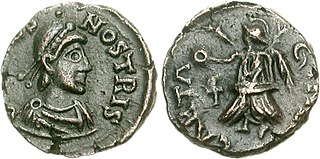
Bonifatius was a Roman general and governor of the diocese of Africa. He campaigned against the Visigoths in Gaul and the Vandals in North Africa. An ally of Galla Placidia, mother and advisor of Valentinian III, Bonifacius engaged in Roman civil wars on her behalf against the generals Felix in 427-429 and Aetius in 432. Although he defeated the latter at the Battle of Rimini, Bonifacius suffered a fatal wound and was succeeded by his son-in-law Sebastianus as patricius of the Western Roman Empire.

This is a chronology of warfare between the Romans and various Germanic peoples. The nature of these wars varied through time between Roman conquest, Germanic uprisings, later Germanic invasions of the Western Roman Empire that started in the late second century BC, and more. The series of conflicts was one factor which led to the ultimate downfall of the Western Roman Empire in particular and ancient Rome in general in 476.

The Franks were a western European people during the Roman Empire and Middle Ages. They began as a Germanic people who lived near the Lower Rhine, on the northern continental frontier of the empire. They subsequently expanded their power and influence during the Middle Ages, until much of the population of western Europe, particularly in and near France, were commonly described as Franks, for example in the context of their joint efforts during the Crusades starting in the 11th century. A key turning point in this evolution was when the Frankish Merovingian dynasty based within the collapsing Western Roman Empire first became the rulers of the whole region between the rivers Loire and Rhine, and then subsequently imposed power over many other post-Roman kingdoms both inside and outside the old empire.
Goar was a leader of the Alans in 5th-century Gaul. Around the time that the Vandals and other Alans under Respendial crossed the Rhine in 405 or 406, Goar's band of Alans quickly joined the Romans, and subsequently played a role in the internal politics of Gaul.

Flavius Felix, sometimes erroneously called Constantius Felix, was a general of the Western Roman Empire, who reached the prominent rank of patrician before being killed probably by order of Aetius. For his consulate in 428 he issued some consular diptychs, one of which has been preserved until modern times.
The crossing of the Rhine River by a mixed group of barbarians which included Vandals, Alans and Suebi is traditionally considered to have occurred on the last day of the year 406. The crossing transgressed one of the Late Roman Empire's most secure limites or boundaries; as such, it has been considered a climactic moment in the decline of the Empire. It initiated a wave of destruction of Roman cities and the collapse of Roman civic order in northern Gaul. That, in turn, occasioned the rise of three usurpers in succession in the province of Britannia. Therefore, the crossing of the Rhine is a marker date in the Migration Period during which various Germanic tribes moved westward and southward from southern Scandinavia and northern Germania.

Ascaric or Ascarich was an early Frankish war leader, who, along with his co-leader, Merogais, are the earliest known leaders explicitly called Frankish, although the name of the Franks is earlier.
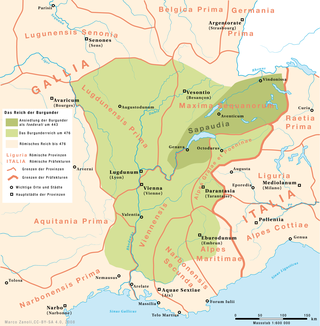
The Kingdom of the Burgundians or First Kingdom of Burgundy was established by Germanic Burgundians in the Rhineland and then in eastern Gaul in the 5th century.

The Gothic revolt of Theodoric I was an uprising of the Gothic Foederati in Aquitaine during the regime of Emperor Valentinian III (425-455). That rebellion was led by Theodoric I, King of the Visigoths and took place in the South of France. The uprising took place between 425 and 426, in the period shortly after the death of usurpator John and was terminated by a military operation under the command of Aëtius.

The Frankish War was a short military conflict between the Frankish people and the West Roman Empire under Emperor Valentinian III. In this conflict, it can only be said with certainty that the Roman general Aetius was involved in it. The presence of King Chlodio of the Salians as captain of the Franks is an assumption and is not confirmed by contemporary sources. The war ended in a Roman victory.

The Frankish War of 431–432 was a short war between the Franks and the Western Roman Empire under Emperor Valentinian III. Like the previous Frankish war, the Roman army was led by the Roman general Aetius and the participation of Chlodio, the king of the Salian Franks is uncertain. The war ended in a Roman victory after which both sides agreed to a peace treaty.















